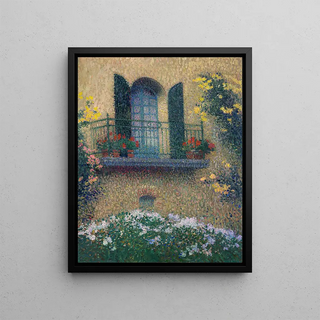Art print | Jaurès Balcony - Henri Martin


View from behind

Frame (optional)
In the vibrant universe of art, some works transcend the mere frame to become witnesses of an era, reflections of society. "The Jaurès Balcony" by Henri Martin is one of those creations that capture the very essence of a historic moment while offering an unforgettable aesthetic experience. This piece, both intimate and social, evokes a scene where political thought and art meet, embodying the passion and commitment of an artist deeply rooted in his time. The soft light bathing the composition, the expressive faces of the characters, and the atmosphere of conviviality invite the viewer to engage in a dialogue between art and life.
Style and uniqueness of the work
Henri Martin, an emblematic figure of post-impressionism, stands out for his ability to play with light and color. "The Jaurès Balcony" is a perfect illustration of his unique style, blending vibrant brushstrokes with a carefully orchestrated composition. The characters on the balcony, depicted in a rich and nuanced palette, seem to emerge from a dream, their expressions revealing emotional depth that engages the viewer. The choice of colors, ranging from warm tones to cooler shades, creates a visual harmony that evokes both joy and melancholy. This art print stands out not only for its technique but also for its subject, which bears witness to a strong social and political engagement, paying tribute to one of the great thinkers of early 20th-century France.
The artist and his influence
Henri Martin, born in 1860, is an artist whose journey is marked by an unceasing quest for beauty and truth. Influenced by masters such as Monet and Van Gogh, he develops a style that is his own, combining impressionist sensitivity with a more structured approach. His social commitment, particularly his admiration for Jean Jaurès, manifests in his works, where he seeks to capture the spirit of a time in full effervescence. Martin does not merely paint landscapes or portraits; he strives to give a voice to his era, to make the struggles and aspirations of his contemporaries resonate.

Matte finish

View from behind

Frame (optional)
In the vibrant universe of art, some works transcend the mere frame to become witnesses of an era, reflections of society. "The Jaurès Balcony" by Henri Martin is one of those creations that capture the very essence of a historic moment while offering an unforgettable aesthetic experience. This piece, both intimate and social, evokes a scene where political thought and art meet, embodying the passion and commitment of an artist deeply rooted in his time. The soft light bathing the composition, the expressive faces of the characters, and the atmosphere of conviviality invite the viewer to engage in a dialogue between art and life.
Style and uniqueness of the work
Henri Martin, an emblematic figure of post-impressionism, stands out for his ability to play with light and color. "The Jaurès Balcony" is a perfect illustration of his unique style, blending vibrant brushstrokes with a carefully orchestrated composition. The characters on the balcony, depicted in a rich and nuanced palette, seem to emerge from a dream, their expressions revealing emotional depth that engages the viewer. The choice of colors, ranging from warm tones to cooler shades, creates a visual harmony that evokes both joy and melancholy. This art print stands out not only for its technique but also for its subject, which bears witness to a strong social and political engagement, paying tribute to one of the great thinkers of early 20th-century France.
The artist and his influence
Henri Martin, born in 1860, is an artist whose journey is marked by an unceasing quest for beauty and truth. Influenced by masters such as Monet and Van Gogh, he develops a style that is his own, combining impressionist sensitivity with a more structured approach. His social commitment, particularly his admiration for Jean Jaurès, manifests in his works, where he seeks to capture the spirit of a time in full effervescence. Martin does not merely paint landscapes or portraits; he strives to give a voice to his era, to make the struggles and aspirations of his contemporaries resonate.






